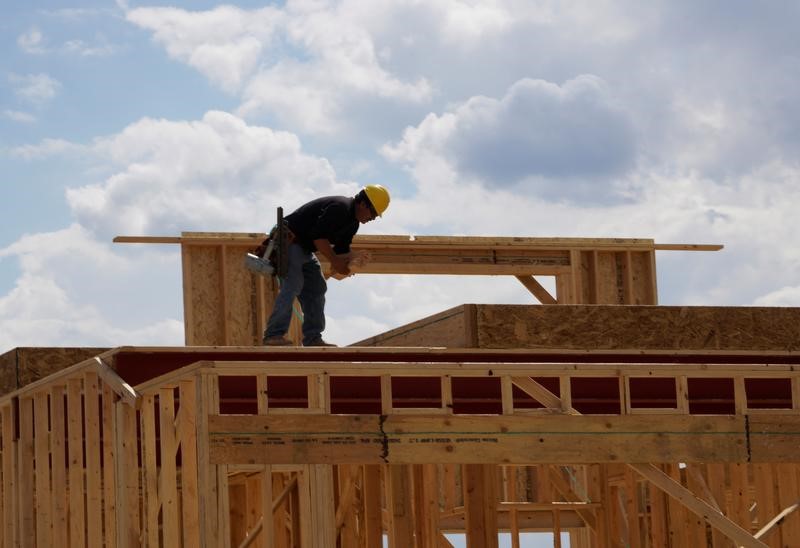
By Lucia Mutikani
WASHINGTON(Reuters) – U.S. manufacturing activity unexpectedly picked up in August amid strong order growth, but a measure of factory employment dropped to a nine-month low, likely as workers remained scarce.
The survey from the Institute for Supply Management (ISM) on Wednesday continued to highlight persistent problems securing enough raw materials, a situation worsened by disruptions caused by the latest wave of COVID-19 infections, primarily in Southeast Asia, as well as ports congestion in China.
“A surprising turn of events for manufacturing activity in the U.S., but it doesn’t change the story of supply disruptions and shortages holding back stronger growth,” said Jennifer Lee, a senior economist at BMO Capital Markets in Toronto.
The ISM said its index of national factory activity inched up to 59.9 last month from a reading of 59.5 in July. A reading above 50 indicates expansion in manufacturing, which accounts for 11.9% of the U.S. economy. Economists polled by Reuters had forecast the index falling to 58.6.
Manufacturing is holding up even as spending is rotating back to services from goods because of vaccinations against COVID-19. All of the six largest manufacturing industries, including computer and electronic products, chemical products and transportation equipment reported moderate to strong growth.
Manufacturers of computer and electronic products said while a global semiconductor shortage was impacting supply lines, they had so far “been able to manage it without impacting clients.”
Chemical goods producers said they continued to “see extended lead times due to port delays and sea container tightness.” Transportation equipment makers reported that “strong sales continue, but production is limited due to supply issues with chips.”
The ISM survey’s forward-looking new orders sub-index rebounded to a reading of 66.7 last month after two straight monthly declines. Fourteen out of 18 manufacturing industries, furniture and related products, machinery and electrical equipment, appliances and components reported growth in new orders. Only nonmetallic mineral products reported a drop.
Demand is being driven by businesses desperate to replenish stocks after inventories were drawn down sharply in the first half of the year. Inventory accumulation, which is expected to be the main driver of economic growth for the rest of this year and into 2022, has been frustrated by the supply constraints.
Stocks on Wall Street were trading higher. The dollar slipped against a basket of currencies. U.S. Treasury prices were mixed.
INFLATION ABATING
Scarce inputs have boosted prices for both manufacturers and consumers. But there appears to be light at the end of the tunnel. The ISM measure of delivery performance of suppliers to manufacturing organizations eased further in August, indicating some improvement in the pace of deliveries.
The survey’s measure of prices paid by manufacturers fell to an eight-month low of 79.4 from a reading of 85.7 in July. This measure has dropped from a record 92.1 in June.
It was the latest indication that inflation has probably peaked. Data last week showed the Federal Reserve’s preferred inflation measure recorded its smallest monthly gain in five months in July.
But worker shortages persist, with ISM chair Timothy Fiore highlighting “a clear cycle of labor turnover as workers opt for more attractive job conditions.”
A measure of factory employment contracted last month and fell to its lowest level since November.
Together with the ADP National Employment Report, which showed on Wednesday that private payrolls increased by 374,000 jobs last month after rising 326,000 in July, the ISM factory index poses a downside risk to job growth in August. Economists had forecast the ADP report would show private payrolls increased by 613,000 jobs.
The ADP report is jointly developed with Moody’s Analytics and was published ahead of the Labor Department’s more comprehensive and closely watched employment report for August on Friday. But it has a dismal record predicting the private payrolls count in the department’s Bureau of Labor Statistics (BLS) employment report because of methodology differences.
According to a Reuters survey of economists, nonfarm payrolls likely increased by 728,000 jobs last month after rising 943,000 in July.
“ADP is far from consistent in predicting changes in the BLS payrolls data,” said Rubeela Farooqi, chief U.S. economist at High Frequency economics in White Plains, New York. “Overall, job growth has strengthened in recent months, even as companies continue to report labor supply shortages.”
The pandemic has upended the labor market dynamics, creating worker shortages even as 8.7 million people are officially unemployed. The were a record 10.1 million job openings at the end of June. Lack of affordable child care, fears of contracting the coronavirus, generous unemployment benefits funded by the federal government as well as pandemic-related retirements and career changes have been blamed for the disconnect.
The labor shortage is expected to ease starting in September. The government-funded unemployment benefits lapse on Sept. 6 and schools are reopening for in-person learning.
But the resurgence in new COVID-19 cases, driven by the Delta variant of the coronavirus, could cause reluctance among some people to return to the labor force.
The labor shortages led to a building up of the backlog of uncompleted work at factories in August.
(Reporting By Lucia Mutikani; Editing by Chizu Nomiyama)




